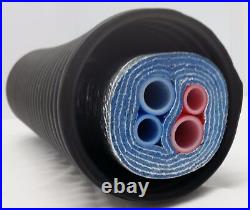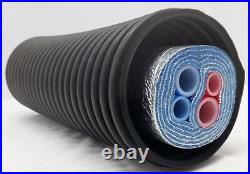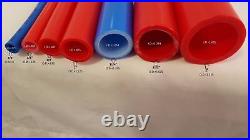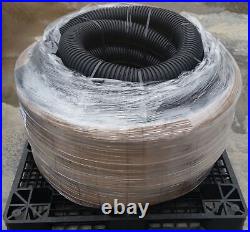




This listing is for Insulated Pipe used for Outdoor Wood Furnaces/Boilers, Geo Thermal, Solar Heating or anywhere you need to transfer heated or chilled fluids. 5 Wraps of Commercial Grade EPE Insulation. 5 Commercial Grade Corrugated Tile. 2 Red Pex Line. 2 Blue Pex Line. All of ours is in a 5 inch tile because there is too much insulation to fit into a 4 tile. Also, there are companies that only install the reflective barrier on one side of the insulation. And to make matters worse, they put it on the side away from the tubing which reduces the effectiveness of the reflective qualities. Yes, we have seen others claiming there tubing tests better than ours. We would advise taking these results with a grain of salt, because we have seen inconsistencies in the claimed results. Test results for BHS Easy Lay Insulated Pipe test 12-30-2010. Temp Loss per 100 ft. Temp loss per ft. Btu loss per Ft. Btu loss per 100 ft. BHS Easy-Lay 1 NOB Insulated Pipe with 3 wraps of EPE Insulation. BHS Easy-Lay 1 NOB Insulated Pipe with 5 wraps of EPE Insulation. For Comparison purposes, some companies only tell you the heat loss for a single line. 62 degrees per 100 ft on our 3 wrap products and. 31 degrees per 100 feet on our 5 wrap products. Q: How deep should this be buried? A: Only 18 to 24 inches is necessary unless it will be driven over. If it will be driven over it should be buried 3 or more feet or placed within a PVC tube or culvert. Q : What is the string for? A : The string which is included with every roll of insulated pipe can be used to pull an electrical, thermostat, tracing wire or whatever through the corrugated tile. Q : What is the outside diameter of the tile? A : The 4″ tile has an outside diameter of 4.7″ and the 5″ tile has an outside diameter of 5.7″. Q : What does “Commercial Grade Corrugated Tile” mean? A : Our corrugated tile is DOT approved for commercial applications which means that it is thicker/stronger than other tile available to the general public. Q : How should the trench for the insulated pipe be prepared? A : The trench should be free of any rocks or debris. If available the corrugated tile should be surrounded by sand. Q : What is the difference between ” Non Barrier ” pex tubing and ” Oxygen Barrier ” pex tubing? A : Non Barrier pex tubing is used for “open” systems. Systems that are non pressurized. Those being ones that water will need to be added to periodically and that also require a type of water treatment. Oxygen Barrier pex tubing has a coating applied to the exterior of the tubing to prevent oxygen from penetrating the tubing. Oxygen Barrier pex is used for “Closed” systems. Systems that are pressurized and once filled do not require additional water to be added nor do they require a water treatment product. Q : How is this product delivered? For residential deliveries, the semi MUST be able to access your location easily to deliver your order. If your location is not easily accessible by semi you will need to make other arrangements e. Business with loading dock or meet the truck to receive your order. It is always best is the order can be delivered to a commercial location. Now a little about us. We also provide parts such as duct coils, brazed plate heat exchangers, tube and shell, hanging heaters, pex tubing, fittings, water treatment and test kits, etc.. Chances are if you need a part for installing your outdoor furnace we have it. Since we provide parts for 1,000’s of customers and dealers across the US we have taken great effort to only provide quality parts at reasonable prices. Many times parts are produced according to our specifications, and made to last. All of our products come with long warranties and we are willing to compare our parts to anything in the industry. We firmly believe in customer service. We also keep tech support people on staff to answer any of your questions about sizing or installation of all of our products. Which Style Of Pex Tubing Should I Use? PEX Tubing: Barrier vs Non-Barrier vs PEX-AL-PEX. Once you have decided to use PEX, you have another decision to make: what kind? Barrier, no barrier, aluminum, let’s get them straight. Making the decision of whether to use Barrier PEX, Non-Barrier PEX, or PEX-AL-PEX is largely based on what job you are going to use it for and what other components you will be working with. All three types of tubing are PEX (Poly Ethylene X-Linked) but some have extra features built in. The “barrier” referred to in PEX tubing is actually an oxygen barrier. This extra layer in your tubing will assure that no oxygen gets into your heating system. Oxygen in your system can be a problem that causes your system components to rust. The oxygen barrier and rust prevention allows you to use cast iron components in your system instead of all brass or bronze, which makes components like pumps and flanges substantially less expensive and keeps them running smoothly for longer. Antifreeze can also break down a system with no oxygen barrier. For radiant heat applications using closed systems, barrier tubing is by far the most popular choice. Non-barrier tubing is simply PEX tubing without the oxygen barrier. For potable water applications, you will generally use non-barrier PEX. Oxygen barrier PEX is made for heating applications and has thus not been approved for plumbing and drinking water. When using tubing without an oxygen barrier, you must be careful to assure that each and every component in your system is non-ferrous (meaning that it contains no iron). Non-barrier PEX Tubing is rarely seen in radiant heat systems, the few systems that do utilize non-barrier PEX are open systems. Non-barrier PEX for plumbing is available in red, white, and blue. Typically, red is used for hot water and blue is used for cold so that you can immediately see which line goes where when looking at a manifold. PEX-AL-PEX is a three-layer PEX Tubing that also has an oxygen barrier. PEX-AL-PEX is a layer of PEX, a layer of aluminum, and another layer of PEX. The main benefit of PEX-AL-PEX is that it holds its shape. Where traditional PEX is flexible, there is nothing that keeps it in place unless you tie it down every few feet. With PEX-AL-PEX, once you bend it, it will hold that shape until you bend it again. PEX-AL-PEX also has less expansion than standard PEX with the layer of aluminum assuring that it keeps its shape. PEX-AL-PEX is frequently used in outdoor heating applications, warmboard systems and for high temperature systems like baseboard and fan coils.

